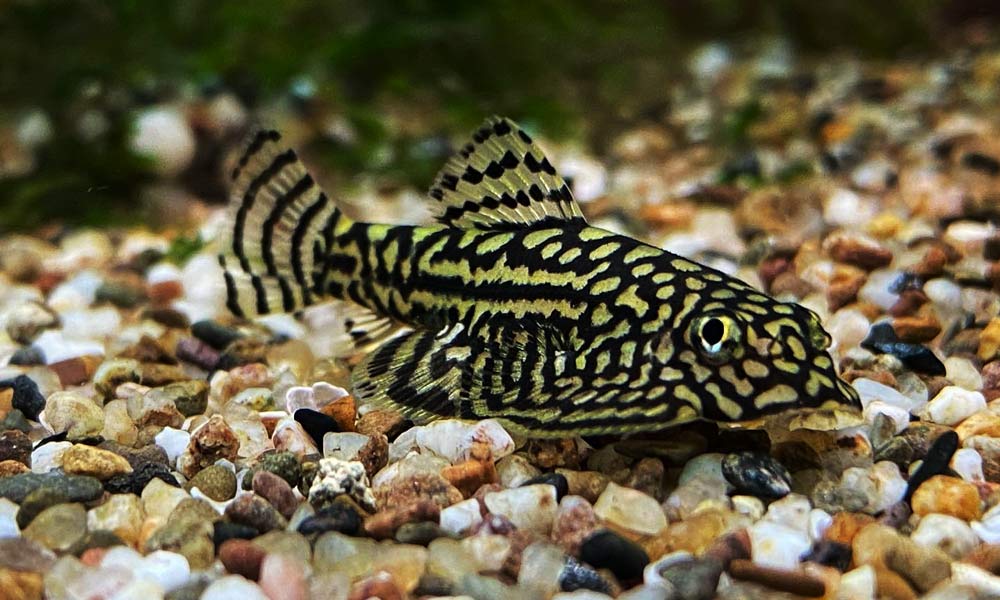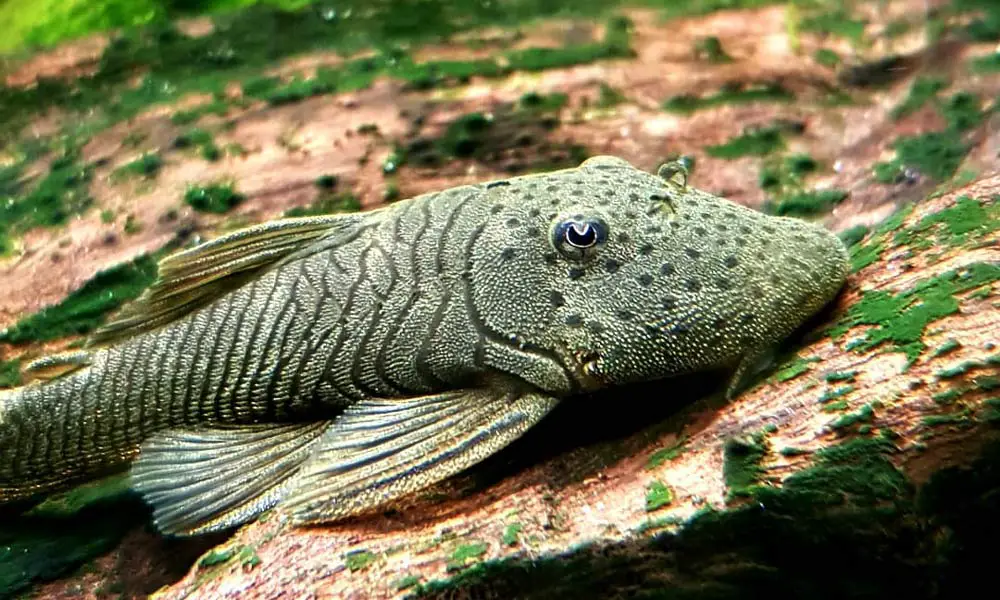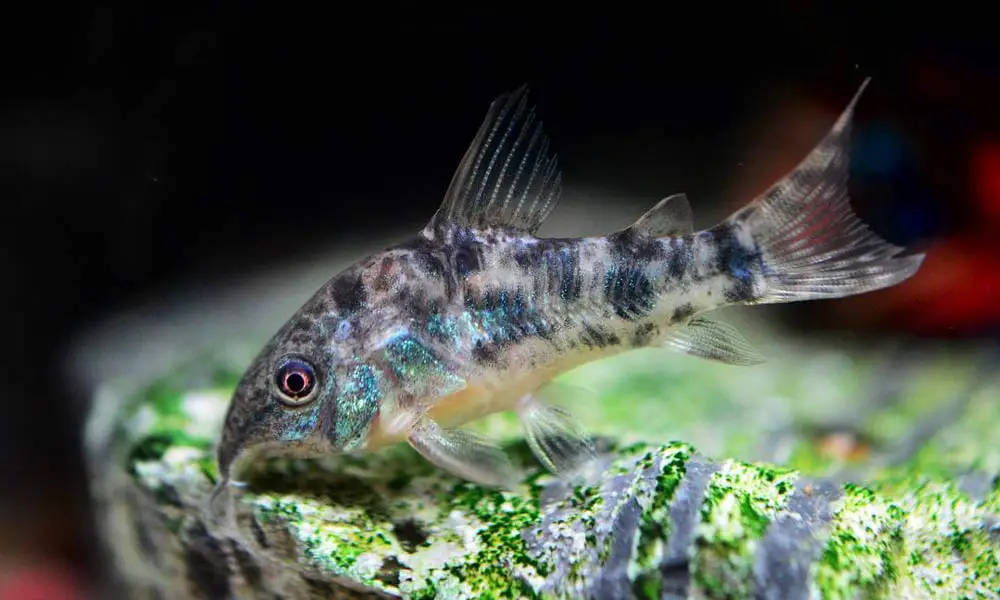If you’re a goldfish keeper or have an indoor koi pond, then you know that keeping your tank/pond free of algae is a never-ending battle. While there are many ways to fight algae, one of the best weapons in your arsenal is cold water algae eaters.
These voracious algae eaters can help keep your tank or pond clean and healthy. So if you’re looking for a way to get the outbreak of algae under control, here are the most well-known 7 cold water algae eaters in the aquarium hobby.
Reticulated Hillstream Loach (Sewellia lineolata)

Reticulated hillstream loaches (Sewellia lineolata), also called the tiger hillstream loach or gold ring hillstream loach, are one of the most unique-looking coldwater algae eaters that don’t get the attention they deserve.
These fish hail from the fast-moving, highly-oxygenated, shallow rivers and streams in Vietnam. In their natural habitat, they spend most of their time on the gravel-sand riverbed scavenging for benthic algae, insect larvae, and detritus.
Reticulated hillstream loaches have a long, stingray-like body covered in a series of dark brown/black stripes that run randomly through their body. These stripes may become more linear on the dorsal and caudal fin.
Like other hillstream loaches, the reticulated hillstream loach requires an aquarium with a strong water flow, plenty of oxygenation, as well as colder temperatures (68-75°F). Since warmer water has a low level of dissolved oxygen, so this fish is less likely to survive in temperatures above 75°.
This small oddball fish only reaches a maximum size of 2.5 inches (6.4 cm), making it the perfect algae eater for goldfish or other unheated small aquariums.
While they are peaceful by nature, they can be territory, so it’s best to keep them in a tank with just one or a group of three or more. In addition, most aquarists only get one simply because of the high price tag.
Rubber Lip Pleco (Chaetostomus sp.)

Looking for an affordable algae eater, you can’t go wrong with the rubber lip pleco (Chaetostomus sp.) Not only does this fish do an amazing job of munching algae, but it’s also one of the most peaceful plecos out there.
Also known as the bulldog pleco or rubbernose pleco, it is not particularly common in the aquarium trade. Additionally, it is often sold as a tropical pleco due to its origin – the Magdalena and Apuré River basins in South America, but this pleco is well suited for your temperate and unheated aquariums.
The rubber lip pleco is a light brown/brown color with black spots dotting its body. The most distinct feature of this fish is the “rubber” lips that give it its name. And beyond that, there is not much to this fish in terms of the appearance of a classical “pleco.”
Rubbernose plecos can reach a standard length(SL) of 5 inches (13 cm), but they are often much smaller in the aquarium than some of the other popular plecos. Of course, if you want an active small coldwater cleaner fish, then it’s a good idea to pass on this fish.
Common Pleco (Hypostomus plecostomus)
Chances are if you’ve been to looking for a clean-up crew in local fish stores, you’ve heard the common pleco (Hypostomus plecostomus). It’s the most popular “marketing” coldwater algae eaters in the pet stores, but personally, I have very little confidence in recommendations for two reasons.
The first and more important is that common plecos don’t consume algae as much as they’re known for. In the wild, these fish are actually more of an omnivore, meaning they consume anything that falls to the bottom of the river.
The second reason I generally don’t recommend common plecos as algae eater is their size. When they are sold, they are only a few inches long and look cute. But when fully grown, they can reach up to 20 inches (51 cm) in length!
This is obviously much too big for the average aquarium, so unless you have a very large tank or pond, I will stay away from this fish. If you’re set on getting one of these fish, then I would recommend getting a juvenile and rehoming it to a larger aquarium or pond when it gets too big.
Pepper Cory Fish (Corydoras paleatus)

We hold a special place in our hearts for corydoras because of how unique and active these little bottom-dwellers are. This small peaceful schooling fish can help keep your tank sparkling clean and tidy without taking on more work on your end.
As a native of southern Brazil, the pepper cory fish (or Corydoras paleatus) is adaptable to cooler waters as long as you provide standard aquarium maintenance.
As with many members of this family, they’re especially fun, interesting schooling fish. Pepper corys are known to produce sound (clicking and grunting noises) when they’re socially distressed or courting.
In terms of appearance, these little guys take on tan or pale olive color with dark and shiny silver spots. They only grow to be about 2.5 inches (6 cm) in length, perfect for small community freshwater tanks.
Amano Shrimp (Caridina multidentata)

While these three coldwater fish are great flat algae-eating machines, they can’t quite compete with the Amano shrimp when it comes to tearing off these unsightly fuzzy algae. Unlike most dwarf shrimp, they’re hard to kill.
The Amano shrimp (Caridina multidentata) is one of the rare algae eaters that will particularly consume black hair algae and beard algae. They will scavenge any dead and decaying matter in the aquarium, as well as debris and dead fish.
Amano shrimp are also known as “Yamato shrimp” or “Japanese algae eaters.” These little creatures are native to freshwater streams and rivers in Japan and Taiwan. They are very hardy and can tolerate a fairly wide range of water parameters.
Compared with other dwarf shrimps in the hobby, these shrimp can attain a maximum size of 2 inches (5 cm) in length. Due to their small size, you’ll need a small group of at least four to make a noticeable difference in your aquarium.
[amazon box=”B079WDZW3T”]Nerite Snails (Neritina natalensis)

Many snails also have a taste for algae, especially hunting down tough green algae that grow in narrow gaps or other hard-to-reach places in your tank. Their persistence and smaller body size make them one of our favorite algae eater critters for freshwater aquariums.
Coming from the Neritidae family, Nerite snails (neritina natalensis) can be found both in freshwater and saltwater locations. Unlike most other aquarium snails, they can’t multiply in freshwater aquarium conditions, so you don’t worry about them overrunning your tank.
Despite the size of Neritidae species varying from species to species, nerite snails stay relatively small, topping out at around 1.5 inches (4 cm). They have a distinctively patterned shell that can be brown, black, or pale yellow in coloration. Some nerite snail varieties also have stripes running along their shells, such as tiger, zebra, horned, etc.
Two things are crucial regarding nerite snail care: a calcium-rich diet and environment to maintain their shells and a high pH level (above 7.0) in the water to help prevent the shell from disintegrating.
Ramshorn Snail (Planorbidae sp.)

We’re featuring the ramshorn snails (Planorbidae sp.) on this list because, unlike other common aquarium snails, most of these snails will eat only delicate plants and have a good appetite for algae.
The ramshorn snail is a member of the Planorbidae family, which includes hundreds of air-breathing freshwater snails. Most of them are often referred to as “minor pest snails” because of their ability to reproduce very quickly and become a nuisance in the aquarium.
Planorbella duryi and Planorbarius corneus are the two species commonly found in aquariums. Moreover, some breeders also market a variety of color morphs through selective breeding, such as albino and blue ramshorn snails. They have a characteristic spiral-shaped shell ranging from 1/2 inch (1.3 cm) to 1 inch (2.5 cm) in diameter.
Although they’re not the most attractive creatures in the freshwater aquarium world, they are excellent scavengers and will consume algae, uneaten fish food, and dead fish.
[amazon box=”B07995Y2MC”]Conclusion
That’s all for our rundown of the best cold water algae eaters for your aquarium. Personally, I really like the Amano shrimp, Nerite snail, and Hillstream Loach for their algae eating abilities. Plus, these little critters are a joy to watch as they go about their business in the aquarium.
Do you have any favorite cold water algae eaters that didn’t make our list? Let us know in the comments below!
